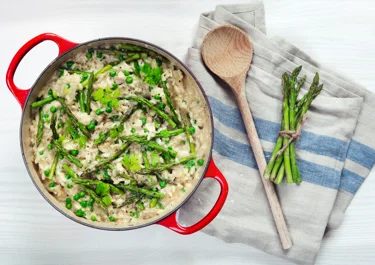
Risotto with asparagus

Instructions
Find the right asparagus
Choosing the right asparagus is crucial for the overall flavour and texture. Look for fresh stalks that are firm and vibrant green with tightly closed tips. Thin spears are ideal for risotto, as they cook quickly and maintain a tender bite. Thicker stalks can still be used but should be peeled to remove any tough outer layers. Add the asparagus towards the end of cooking to retain its bright colour and fresh flavour.
Fresh vs. frozen peas
You can use both fresh and frozen peas. When in season, fresh peas bring a delicate sweetness and firm bite. Add them near the end of cooking to preserve their bright green colour and fresh flavour. Fresh peas are particularly well-suited to springtime risotto when they are in season alongside asparagus. Frozen peas offer year-round convenience and retain much of their sweetness and texture. Although slightly softer due to blanching before freezing, they still provide a pleasant flavour. When using frozen peas, add them straight from the freezer towards the end of cooking to prevent them from overcooking and to maintain their bright appearance.
Season at the right time
Seasoning risotto at the right time is important for balanced flavour. Add salt early in the cooking process so the rice absorbs it along with the stock. Once you add Parmesan cheese, however, be cautious about adding more salt. Parmesan has a naturally salty taste, and too much additional salt can overwhelm the flavours. Adjust the taste along the way to ensure the risotto stays balanced without becoming overly salty.
Keep stirring
Stirring is a crucial part of making risotto because it encourages the rice to release its natural starches, which gives it its creamy texture. Using a wooden spoon is best, as it is gentle on the rice grains, preventing them from breaking and affecting the texture. Stirring also helps the liquid and rice combine evenly, ensuring a smooth and consistent result. The more you stir, the creamier the risotto becomes, but be sure not to over-stir, as this can lead to a dense or overly thick texture.
Serve your risotto promptly
After the risotto has rested with the lid on for 10 minutes, serve it right away. Risotto is at its best when freshly made and warm, retaining its smooth texture and rich flavours. If left too long, it can become too thick or cool down, losing its appealing consistency. A quick stir before serving helps restore the creamy texture.
Adjust the texture
Getting the texture just right is critical for a good risotto. If it feels too thick or stiff, gradually add a small amount of water or stock to loosen it. Stir continuously as you adjust the liquid to maintain a smooth, creamy consistency without making the risotto runny. The goal is to have the risotto hold its shape while still being fluid enough to spread slightly on the plate.
FAQ: Questions about risotto with asparagus
This recipe for risotto with asparagus will quickly become a family favourite. Below, you will find answers to some common questions to help you perfect this Italian classic.
Nutritional values
Nutritional value, per
4099 Kcal
| Fibre | 33.3 gram fibers |
| Protein | 139.8 |
| Carbohydrates | 358.1 |
| Fat | 227 gram |
Ingredients
Risotto rice | 400 g |
|---|---|
Extra virgin olive oil | 100 ml |
Shallots | 4 |
Garlic cloves | 4 |
Fennel bulbs | 2 |
White wine or 2 tbsp white wine vinegar | 100 ml |
Thyme | 1 stalk |
Vegetable or chicken stock | 1½ l |
Parmesan cheese, grated | 200 g |
Butter | 2 tbsp |
Cream cheese | 150 g |
Sea salt and freshly ground pepper | |
Mini green asparagus | 150 g |
Frozen green peas | 100 g |
Dig into our creamy risotto with asparagus
Indulge in a risotto that celebrates the delicate flavours of fresh vegetables and the comforting allure of Italian cuisine. Each spoonful of our risotto with asparagus offers a delightful combination of tender rice, fresh asparagus, and sweet peas. The balance of textures is what makes this risotto truly stand out – plump grains of rice that hold a gentle bite, complemented by the subtle crispness of asparagus and the smooth finish of Parmesan and cream cheese.
Brimming with bright, earthy vegetables
The combination of asparagus and peas adds both colour and flavour to the risotto. Asparagus brings an unmistakable freshness with its tender stalks and slightly nutty undertones, adding a pleasing crunch that contrasts with the rice.
Meanwhile, peas provide a gentle sweetness that plays off the other ingredients, offering a delicate balance between richness and lightness. The way these vegetables interact with the creamy rice results in a fresh yet indulgent taste.
Visually, the vivid green specks of asparagus and peas scattered throughout the risotto add an inviting vibrancy that hints at the flavours to come. With every mouthful, you get a little bit of everything – earthy, sweet, and slightly savoury – coming together in a way that keeps you reaching for just one more bite.
Flavoursome base from sautéd onions and rich vegetable stock
The deep flavour in this risotto starts with its savoury base, created from slowly sautéd onions that add a gentle sweetness. As they soften, the onions release their natural sugars, laying down the first layer of richness that infuses every grain of rice. This is complemented by a rich vegetable stock that helps develop the characteristic, rich, and smooth texture that envelops the rice.
An indulgent touch from Parmesan and cream cheese
A generous addition of Parmesan and cream cheese is what gives this risotto its unmistakable richness. The grated Parmesan melts seamlessly into the warm rice, infusing it with its nutty, savoury character, while the cream cheese introduces a mild tang. The result is a risotto that feels indulgent without being overly heavy, offering just enough richness to leave an impression.
A terrific Italian classic for the whole family
This risotto with asparagus is a wonderful example of Italian cooking at its best, blending simple ingredients with a careful cooking approach to create something truly satisfying. Although risotto has its origins in northern Italy, it has become beloved worldwide for its comforting, yet refined appeal.
With its inviting appearance and balanced taste, this risotto easily transitions from a casual weeknight dinner for the whole family to a more celebratory meal for special occasions. Serve it with a crisp salad or a slice of rustic bread, and you have a complete meal that brings everyone together around the table.
If you love this risotto, explore more Italian-inspired recipes. Discover the comforting potato ravioli with its delicate pasta and savoury filling, or enjoy our rustic polenta pizza. For something fresh, the zesty courgette lemon pasta offers a bright and refreshing flavour. You might also enjoy the flavourful olive focaccia topped with cheese and herbs or indulge in the elegant lobster risotto.
Get creative with the ingredients
Risotto is wonderfully versatile, offering endless ways to explore new flavours and textures. For a richer, savoury twist, try adding crispy bacon pieces to create a delicious bacon risotto. Sautéd mushrooms bring an earthy depth, and roasting or grilling the asparagus before adding it can enhance its natural sweetness, yielding a subtle smokiness that adds complexity to each bite. You can also experiment with seasonal vegetables like broad beans or courgettes, adding a fresh element.
To brighten the overall flavour, a touch of lemon zest stirred in towards the end adds a refreshing zing. If you are feeling adventurous, sprinkling toasted pine nuts on top introduces a delicate crunch and a hint of nuttiness.
For extra brightness, garnish with finely chopped fresh chives or parsley just before serving to elevate both the appearance and taste. A drizzle of truffle oil brings an aromatic finish, making the dish feel more special without overpowering its delicate flavours.










